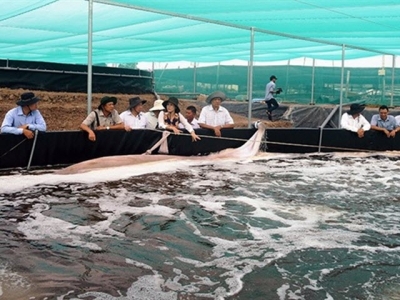Kiên Giang to shift rice fields to aquaculture

Shrimp breeding and rice cultivation are rotated on the same field in Kiên Giang Province’s An Biên District. - Photo nhandan.com.vn
Ho Chi Minh City – Kiên Giang Province, the country’s largest rice producer, plans to shift 86,625ha of unproductive rice fields to aquaculture and cultivation of other high-value crops from now to 2020.
Of the rice fields, 3,420ha will be used to grow perennial trees, 10,492ha for short-term crops, and 72,713ha for rotating shrimp and rice or fish and rice on the same field, according to the province’s Department of Agriculture and Rural Development.
Mai An Nhịn, deputy director of the department, said the conversion of rice fields was being done to suit the ecology of each area. This will increase income for farmers and establish concentrated agricultural and aquaculture areas that meet market demand, he said.
The Cửu Long (Mekong) Delta province has instructed agencies to set up detailed plans to convert the rice fields and has also encouraged the establishment of agricultural co-operatives to produce a large quantity of agricultural products and improve profits for farmers.
In the 2017-18 winter- spring rice crop, about 150 rice co-operatives signed contracts with 10 companies to grow more than 32,000ha of rice, and were guaranteed outlets.
The province has improved the transfer of advanced techniques to farmers so they can produce high-quality agricultural and aquatic products for export.
Shrimp-rice farming
In the past, Kiên Giang specialised in planting only rice, and in recent years, under the encouragement of local authorities, more farmers have rotated shrimp and rice in fields which lack fresh water in the dry season.
The province now has nearly 90,000ha devoted to the shrimp - rice rotation model, the largest area of its kind in the delta.
Dương Tuyết Nga, who has rotated farming shrimp and rice in her field in Hòn Đất District’s Thổ Sơn Commune, said the model had helped her family escape poverty.
“Rotating shrimp and rice has a higher profit than planting only rice, so many households have switched to this model,” she said.
Under the model, farmers plant rice in the rainy season and breed shrimp in the dry season on the same field.
The model offers farmers an average profit of VNĐ21 million (US$925) per ha for a rice crop and an average profit of VNĐ29 million ($1,300) per ha for a shrimp crop.
Đào Xuân Nha, head of the Hòn Đất District’s Agriculture and Rural Development Bureau, said the model had reduced pollution and disease among shrimp.
The province’s shrimp-rice farming model includes one crop of black tiger shrimp and one rice crop a year, and two crops of white-legged shrimp and one rice crop a year.
The model produces clean rice and shrimp as farmers use less chemicals and the shrimp eat natural food in the fields. The model is suitable for areas affected by saltwater intrusion in the dry season.
The model produces about 300 - 500 kilo of shrimp and four to seven tonnes of rice per ha a year.
However, irrigation systems at shrimp- rice farming areas have not been perfected, so saltwater intrusion has entered deep inland.
In addition, farmers’ profits from a shrimp crop are much higher than that of a rice crop, so many farmers breed two shrimp crops in their fields and do not grow a rice crop.
The province plans to focus on investing in infrastructure and farming techniques for the shrimp- rice farming model and establish a brand name for these areas, according to its Department of Agriculture and Rural Development.
The province aims to have 90,000ha devoted to shrimp-rice rotation by 2030
Related news
Tools

Phối trộn thức ăn chăn nuôi

Pha dung dịch thủy canh

Định mức cho tôm ăn

Phối trộn phân bón NPK

Xác định tỷ lệ tôm sống

Chuyển đổi đơn vị phân bón

Xác định công suất sục khí

Chuyển đổi đơn vị tôm

Tính diện tích nhà kính

Tính thể tích ao



 Measures sought to facilitate Vietnam’s shrimp export to…
Measures sought to facilitate Vietnam’s shrimp export to…  Climate change impacts unite U.S. shellfish farmers
Climate change impacts unite U.S. shellfish farmers